Remain in Control
From time to time, your horse is going to spook at objects on the trail. He might spook at a sign, a bush, a rock formation … the objects he could potentially spook at are endless. But having a fail-safe approach to handling a spook and remaining in control of the situation will make the incident a minor inconvenience rather than a ride-ruiner and will provide an opportunity to train your horse and make him a better partner.
In the past, you may have dealt with a spook by stopping and facing the “scary object” while attempting to coax your horse up to it and convincing him it wouldn’t hurt him. This approach involves a lot of patting and rubbing and “There, there, Precious,” murmurings. Though this approach may eventually work, it takes a very long time and probably won’t keep your horse from spooking at the same object again, the next time he sees it.
Rather than stopping a horse and persuading him to approach a spooky object—a very predator-like move— you’re going to put your horse’s feet to work around the object. It’s more effective and safer than letting your horse tense up and revert to the reactive side of his brain. Moving his feet around the object, constantly changing directions, will get him to use the thinking side of his brain and tune in to you. Horses can only think of one thing at a time—your horse is either focused on the spooky object or thinking about how you’re asking him to hustle his feet.
Plus, having a plan to direct your horse’s feet gives you something to do other than react to your horse’s fear. And, while you’re training your horse not to spook, you’ll also be suppling him and gaining more control of him.
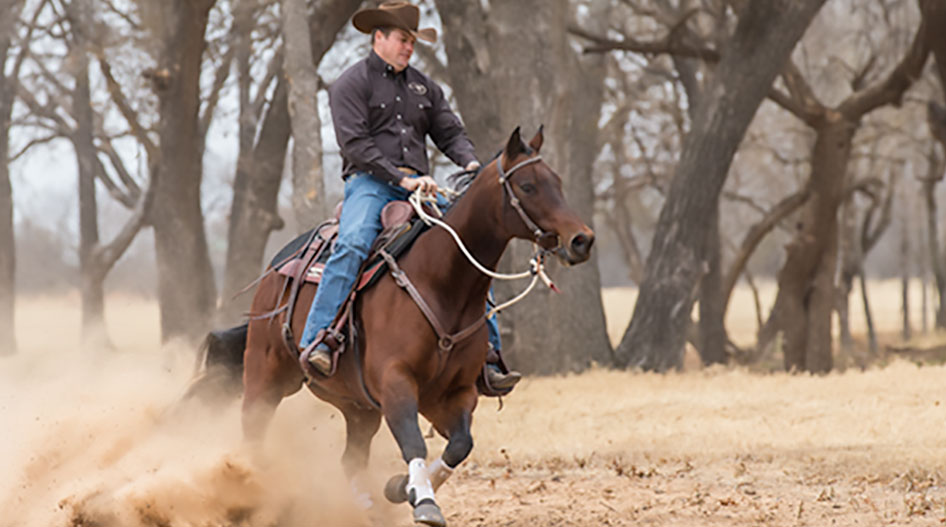 When a horse spooks, he uses the reactive side of his brain and his only concern is running as fast as he can from his fear.
When a horse spooks, he uses the reactive side of his brain and his only concern is running as fast as he can from his fear.
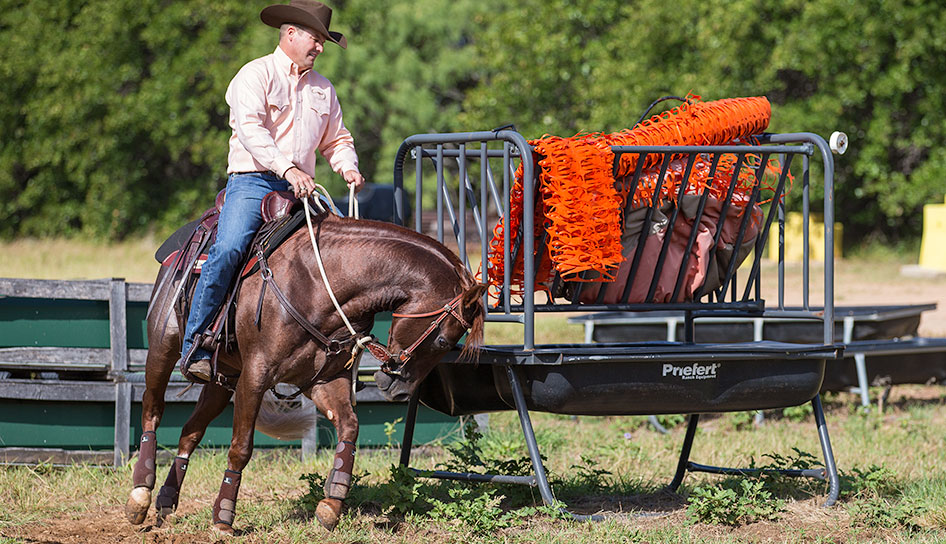 If you can tell what your horse spooked at, circle the object, if possible, and every one and- a-half circles, turn the horse in toward the object. Each time the horse turns in toward the object, he’ll get closer to it.
If you can tell what your horse spooked at, circle the object, if possible, and every one and- a-half circles, turn the horse in toward the object. Each time the horse turns in toward the object, he’ll get closer to it.
Redirect Nervous Energy
When your horse spooks at an object, put his feet to work immediately. Trot him in a circle around the object, or if you’re not able to circle the object, circle in front of it. You can even trot or lope him back and forth in front of the object, such as a fence line. Your first order of business is to establish a starting point—a distance far enough away from the object so you can ride the horse around it without him getting anxious. If your starting point is 50 feet away from the object, that’s fine.
When your horse gets frightened of something, he uses the reactive side of his brain and is full of nervous energy. Rather than letting that nervous energy explode into a dangerous situation, put it to good use. Every one-and-half circles, reverse directions by turning your horse in toward the objectand doing a little rollback. Then continue to circle the object in the opposite direction.
Hustling your horse’s feet around the object and changing directions will get him to use the thinking side of his brain. Rather than focusing on his fear of the object, he’ll have to pay attention to you and think about how he’s placing his feet.
When you’re circling the object, the key is to HUSTLE the horse’s feet. If you let him walk and dillydally around, it’ll be worthless. There is no incentive for the horse to ever focus on you and stop worrying about the object because he can walk and turn for hours. Put his nervous energy to good use and give him a reason to focus on you.
As your horse becomes more and more focused on circling and rolling back in toward the object, he’ll naturally get closer to it. Every time he turns in toward the object, he’ll get a step or two closer to it. Always turn the horse in toward the object, using your outside leg to drive his front end through the turn. If you turn him away from it, the negative energy from the object will drive him farther away from what he’s afraid of.
Eventually, the horse will get a little tired from all the trotting and rollbacks and will be in a good frame of mind to start using the thinking side of his brain. He’ll realize that there is no reason for him to use a lot of energy turning and doing rollbacks. Instead of a crisp rollback, where he’ll pick his front end up and jump it through the turn, he’ll start doing screaming U-turns, where he’ll trot through the turn. When he “cheats” you like this, let him. Let him realize that it’s much easier to slow down and take his time. If he’s paying attention to you and offers to slow down, don’t make him feel wrong for that. That’s the complete opposite of him using the reactive side of his brain and running away from the object.
Before long, the horse will be circling and turning right in front of the object. When you can feel that he’s got his attention on you and isn’t worried about the spooky object, let him rest next to it on a loose rein. At this point, the horse will be huffing and puffing a little bit and looking for a rest and will willingly take you up on your offer to stand quietly beside the scary object. If he wants to investigate it (smell it, paw at it, etc.), let him. While he’s resting next to the object, rub all over him. Make him feel comfortable for standing next to the object.
 Eventually, you’ll be able to rest him right next to the object that spooked him.
Eventually, you’ll be able to rest him right next to the object that spooked him.
If you can’t ride around the object, circle in front of it at the trot or lope using the same concept. When you come up to the object, stop your horse, using one rein, roll back and ride off in the new direction. Each time you stop and roll your horse back, he’ll get closer to the object until eventually he’s right next to it.
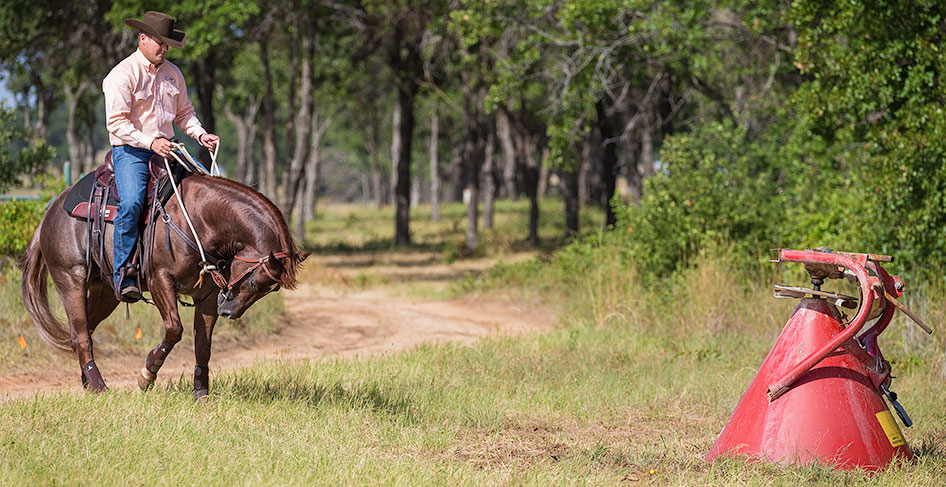
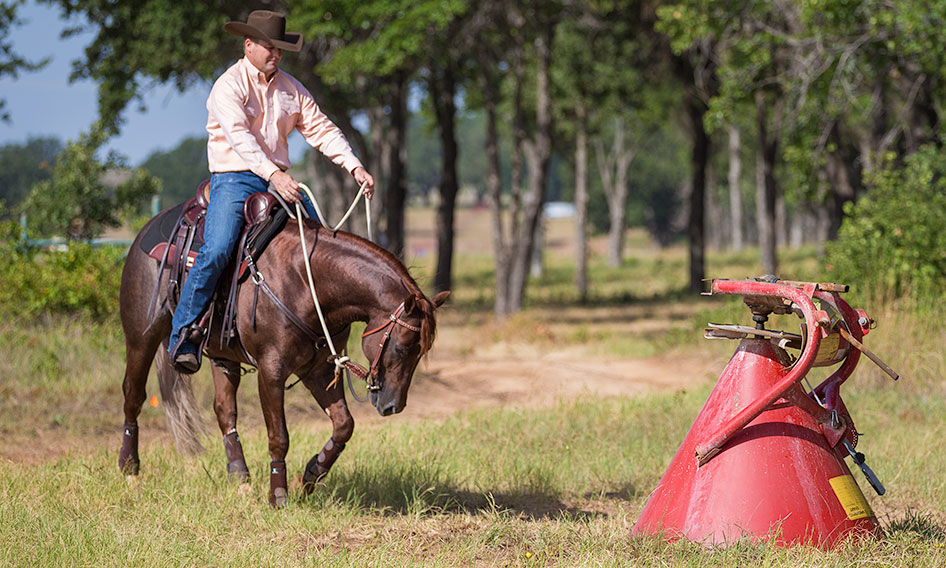 If you can’t circle the object, you can always use Approach and Retreat to get the horse to confidently walk up to the object. Ask the horse to walk forward toward the object, and then, before he stops, ask him to back away from it.
If you can’t circle the object, you can always use Approach and Retreat to get the horse to confidently walk up to the object. Ask the horse to walk forward toward the object, and then, before he stops, ask him to back away from it.
How Vision Affects Your Horse’s Spooky Behavior
Does your otherwise steady horse get nervous on dense, narrow trails? Not to worry—his behavior is completely normal. Here’s why:
Your horse uses each of his eyes separately to see the world around him. Your eyes, set in the middle of your face, give you a natural ability to focus on a narrow trail ahead of you and keep peripheral distractions to a minimum. But because your horse is a prey animal, his eyes are set on the side of his head, giving him relatively poor straight-ahead vision but excellent wide-field vision, which is necessary for spotting predators. Except for two small blind spots, one right in front of his nose and another directly behind his tail, your horse can nearly see 360 degrees around his body. That’s why he notices objects or movements behind him that you can’t even see without turning around. Being able to see all around his body helps the horse spot predators lurking in the wild.
Dense woods eliminate your horse’s wide field of vision and complicate matters with changing patterns of dappled light. Horses have poor depth perception as it is. It is hard for a horse to tell how far away an object is from him or how deep an object is, particularly when it is close to him. That’s why horses will often bob their heads up and down when they’re looking at objects that are up close and down low to them—they’re trying to get a grasp of them. With limited sight on a dense, narrow trail, it’s common for horses to feel nervous about what might be coming out of the woods, which increases their spookiness. It can also make horses extra defensive and they may kick out at horses that approach them from the side or behind.
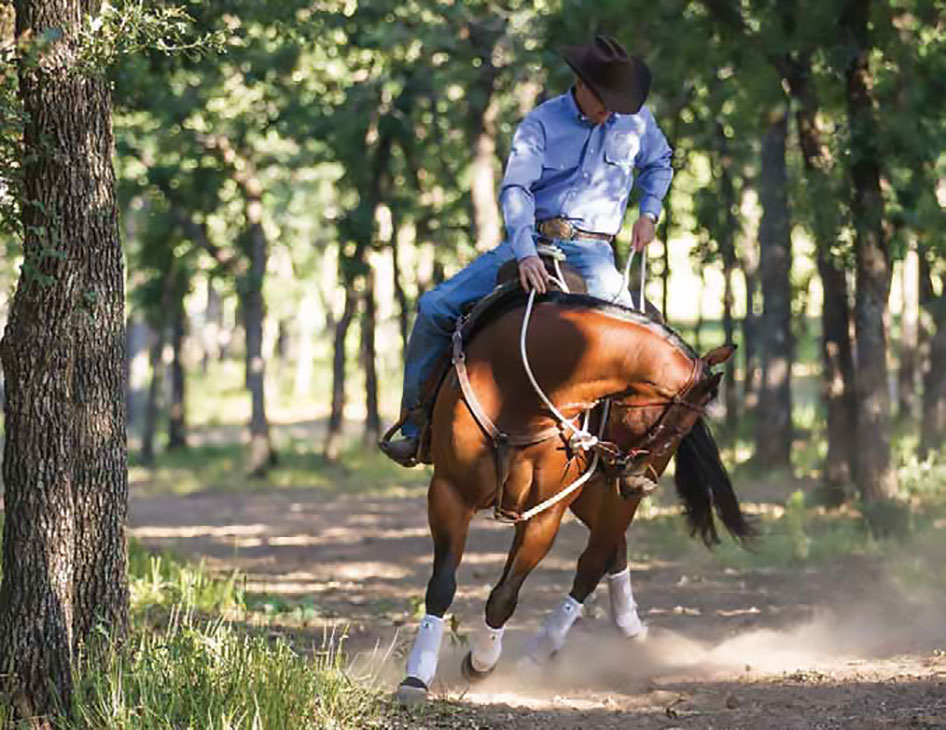 Dappled light can affect your horse’s vision and cause him to be overreactive.
Dappled light can affect your horse’s vision and cause him to be overreactive.
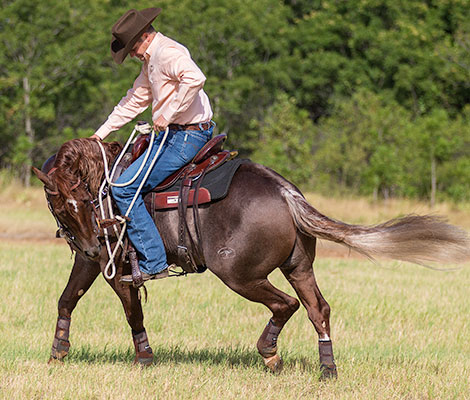

If you can’t tell what your horse spooked at, put his feet to work—doing as many changes of direction as you can—to get him to use the thinking side of his brain. I’m practicing serpentines here.
AN INVISIBLE OBJECT
If your horse “spooks for no reason”— you’re riding down the trail and all of a sudden he jumps forward, leaps sideways and takes off, you’ll incorporate the same philosophy—put his nervous energy to good use.
If you feel like you are not in control of the situation, or if you are unsure of your riding ability, do a One Rein Stop to regain control of your horse.
The One Rein Stop is your emergency brake: Anytime you feel out of control, you can slide your hand down one rein and pull it up to your hip and your horse should instantly stop. In order for the One Rein Stop to work, however, it has to be an ingrained habit for both you and your horse, which means you have practiced it a lot in a controlled environment. Knowing the theory of a One Rein Stop won’t do you any good on the trail if you haven’t ever taught it and practiced it with your horse.
Once you’re back in control of the situation, put the horse’s feet to work. Using one rein, bend him in a series of serpentines. It’s impossible for a horse to use the reactive side of his brain when he’s constantly redirecting his feet. When he’s focused on you, put him on a loose rein and head back down the trail. Anytime he gets jumpy, put his feet to work. Soon he’ll be so focused on you he won’t have time to find potential objects to spook at. I honestly think that some horses get in the habit of spooking because they get away with it. And sometimes, if they can intimidate their rider enough, they learn they can get out of work by spooking.
I want my horses to know that every time they spook, I’m going to put their feet to work and make them sweat. Remember, the worst punishment you can give a horse is making him hustle his feet and work hard. When it comes right down to it, horses are lazy creatures and would rather stand still than hustle their feet.
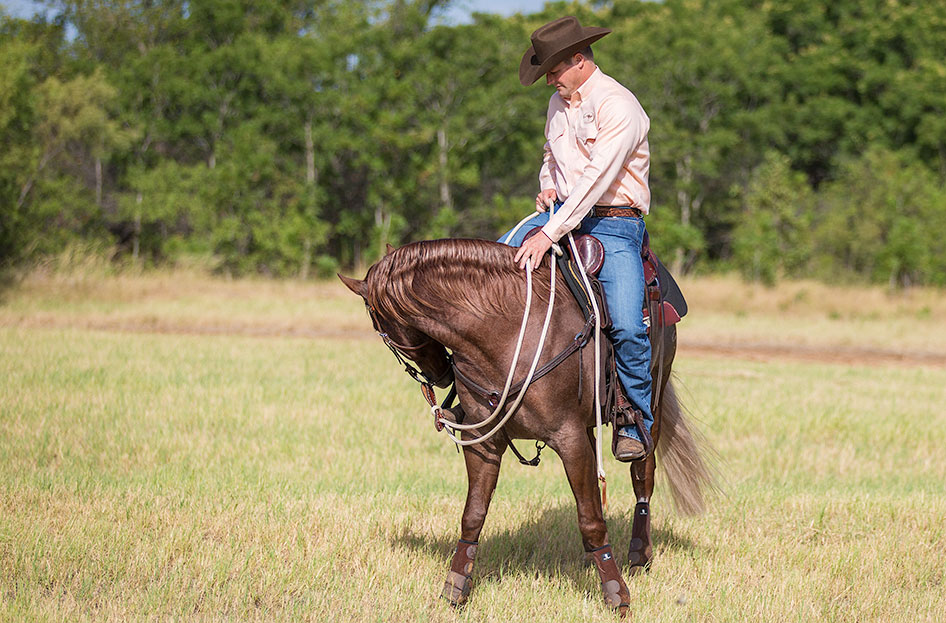 If your horse spooks and you feel like the situation is out of control, do a One Rein Stop.
If your horse spooks and you feel like the situation is out of control, do a One Rein Stop.
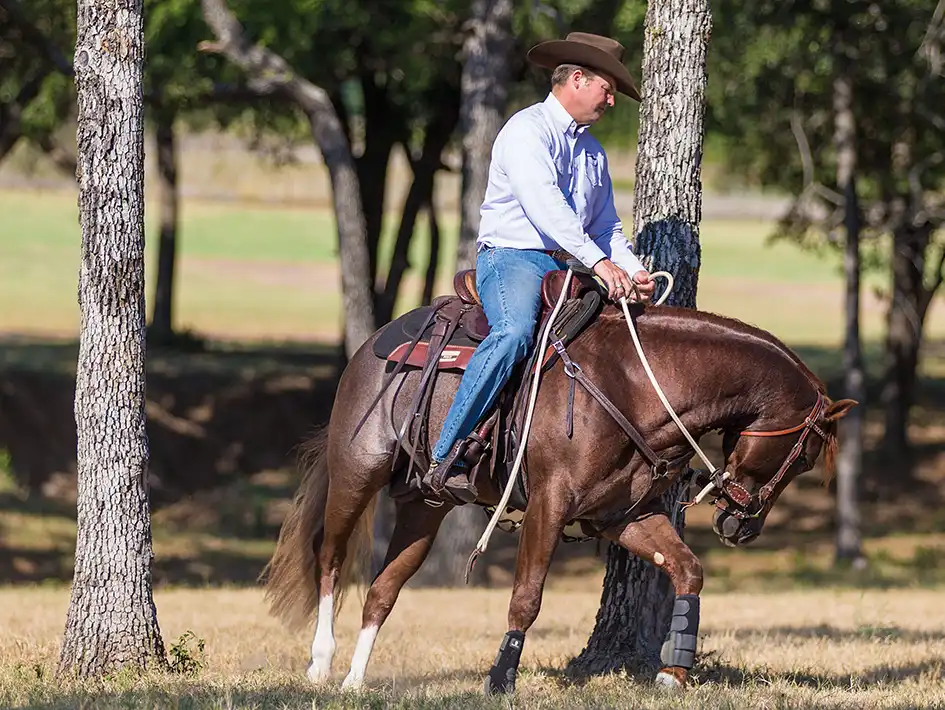
The best way to stop your horse from spooking is to be a leader on the trail and give him a reason to pay attention to you rather than finding objects to spook at.
BE A LEADER FOR YOUR HORSE
When on the trail, a lot of people put their horse on a big, loose rein and let their mind wander or gab with friends. They put their horse on what I call “autopilot”—he’s left on his own, which for a lot of horses means they go down the trail constantly looking for something to spook at.
Horses have the quickest reaction time of all domesticated animals, and if you let your horse wander down the trail without paying attention to him and he spooks, you’re going to be in a wreck before you have time to react and regain control of the situation. I’m not telling you to be paranoid and go down the trail thinking that any little thing is going to set your horse off, but you need to constantly be reminding your horse to check back in with you.
When I take my horses out on the trail, I bend them around trees, sidepass them over logs, two-track them down the trail, practice bending transitions— anything I can think of to remind them to focus on me and stay soft and supple at the same time. Remember, if you don’t give your horse something positive to think about, he will naturally drift toward something you don’t want him to think about.
SUCCESS TIPS:
Warm up with groundwork.
Before hitting the trail, be sure your horse is in the right frame of mind, meaning he’s calm, using the thinking side of his brain and focused on you. Most of the time, horses spook because they’re fresh and using the reactive side of their brains. Don’t just pull your horse out of the pasture, throw the saddle on him and head out on the trail. Set yourself up for success by practicing groundwork and reminding your horse that you are the leader and he needs to respect you and let you call the shots. If you’re at home, practice groundwork exercises, such as Lunging for Respect Stage Two, the C-Pattern, Sidepassing, etc., in the arena.
If you’ve trailered your horse somewhere for a ride, find an open area where you can get his feet moving and changing directions. Remember, in order to get a horse to respect you and use the thinking side of his brain, you have to move his feet forwards, backwards, left and right. The more you ask the horse to change directions, the sooner you’ll get his attention. The entire time that you’re working with the horse on the ground, he should be hustling his feet. Don’t just let him lazily jig-jog around. You want to get rid of any freshness he might have before taking him out on the trail.
Routinely introduce spooky objects to your horse.
One of the best things you can do to build your horse’s confidence on the trail is to introduce him to as many spooky objects as you can. I have a junkyard of sorts on the ranch where I store discarded machinery parts and other items around the ranch, such as old hay feeders, Ritchie waterers, pipes, concrete slabs—you name it, it’s probably hiding out here! This area makes a great de-spooking tool for horses in training because there’s an endless number of objects they can spook at.
When an Academy Horse comes in for training, the first few times he’s taken out to the junkyard he spooks at nearly everything and the Academy student has to circle and turn him back in toward almost every object. By the horse’s last week on the ranch, he can ride around the entire junkyard on a loose rein and he’s bored to tears. I love it when my horses go down the trail like that.
While you can’t possibly introduce your horse to every single object he’ll ever encounter on the trail, what you can do is give him the tools to confidently work through a situation in which he gets spooked by an object. If you’re always consistent about immediately putting the horse’s feet to work and circling him around the object until he’s using the thinking side of his brain and is confident enough to stand next to it, it’ll take you less and less time to go through that process with each object.
You’ll also find that the more you introduce your horse to spooky objects and use the steps I described to work him around them and get him to use the thinking side of his brain, the less he’ll actually spook. Even if he’s never seen an object before, he’ll be less likely to use the reactive side of his brain and panic. As soon as you feel the slightest bit of nervousness from him, you’ll direct his feet. You’ll take control of the situation and be a confident leader. Your horse will learn to trust you because you get him safely out of situations in which he’s scared.
Imagine the thinking side of your horse’s brain as a muscle. The more you use a muscle, the stronger it gets. Let’s say I went to the gym every day for a year and I lifted weights with my right arm. At the end of the year, my right arm would be bigger and stronger,and it would be more useful to me. Now, let’s say that after a year I quit going to the gym. What would happen to my arm then? Every day my arm would get weaker, flabbier and less useful. Pretty soon, I wouldn’t be able to do as much with the arm as I used to.
That’s the way you need to look at the thinking side of your horse’s brain. It’s like a big muscle, and the more you exercise and use it, the more proficient it will get. The less you use it, the weaker and less useful it becomes.
Some horses get really smart about spooky objects and realize that if they go up to a “scary” object they get a rest, and they will actually try to go up to objects just so they can get to stand still and relax. It’s a really good problem to have.
Do not be aggressive.
Although it’s important to hustle your horse’s feet when he spooks, do not do so aggressively. If you’re jerking on his mouth and spurring him in the belly, you’ll only cause him to be more reactive and his spooking problem will never go away. Hustle his feet to give him a job to do and get him to use the thinking side of his brain, but be aware of how you’re doing it.
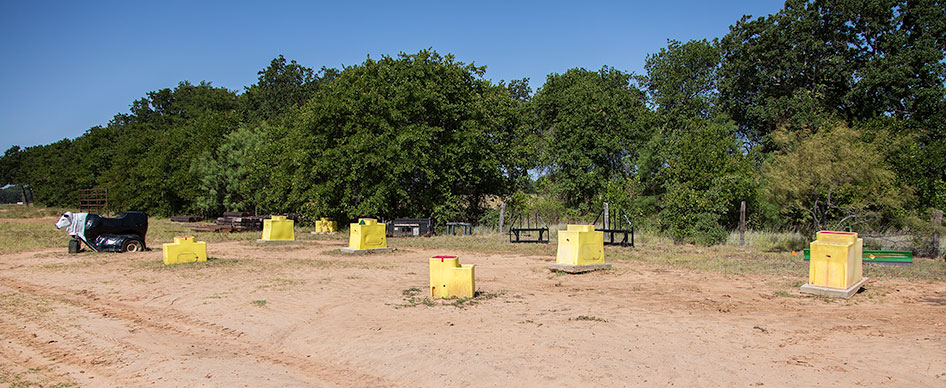
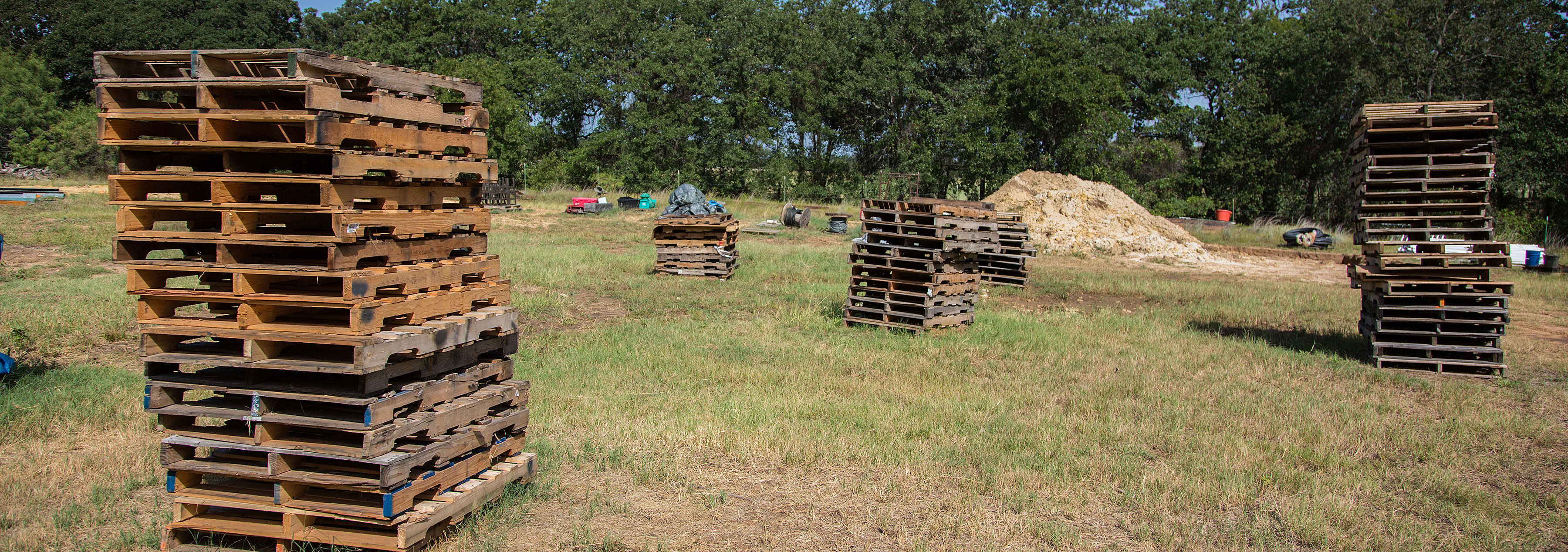 The “junkyard” at the ranch is full of discarded items that make excellent training tools to de-spook horses.
The “junkyard” at the ranch is full of discarded items that make excellent training tools to de-spook horses. Big, stationary objects often frighten horses. To get your horse to confidently approach the object, circle him in front of it or around it.
Big, stationary objects often frighten horses. To get your horse to confidently approach the object, circle him in front of it or around it.
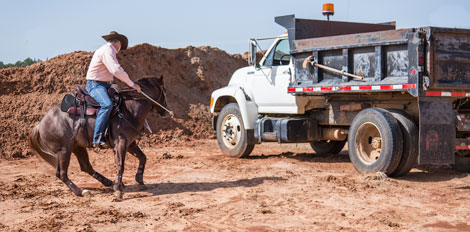
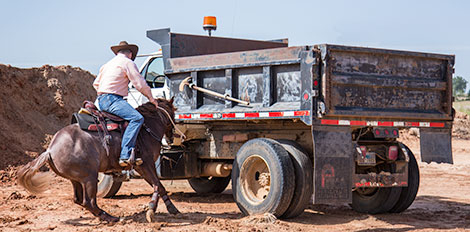
Every one-and-a- half circles, turn the horse into the object so that he has to roll over his hocks. Initially, you probably won’t be able to get the horse very close to the object, but with each turn in toward the object, the horse will get closer to it.
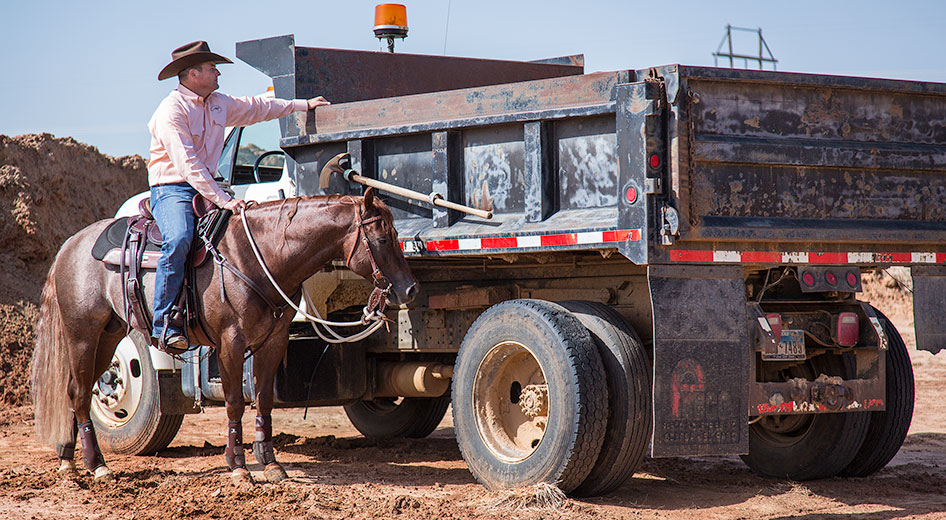 Big, stationary objects often frighten horses. To get your horse to confidently approach the object, circle him in front of it or around it.
Big, stationary objects often frighten horses. To get your horse to confidently approach the object, circle him in front of it or around it.
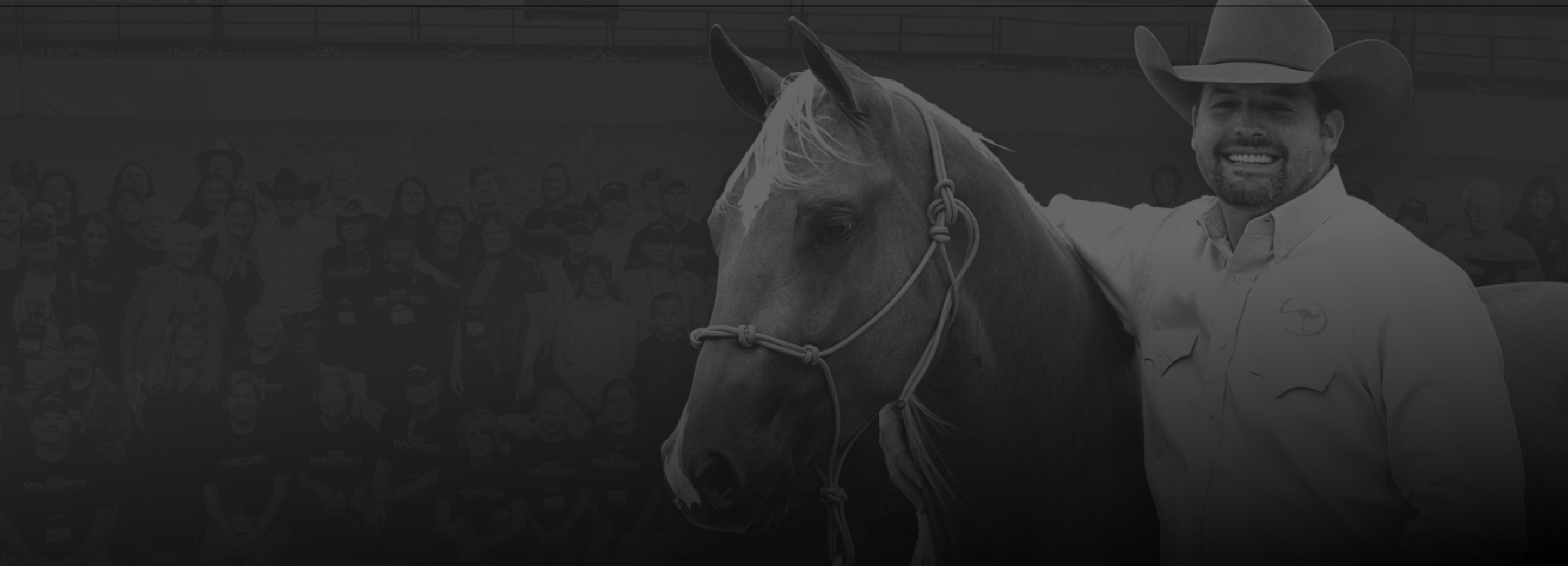

Want To Learn More? SIGN UP FOR OUR LOYALTY PROGRAM
Master your horsemanship training through Clinton’s step-by-step method videos by joining the No Worries Club today. Becoming a club member ensures you get VIP pricing on all of Clinton’s must-have training tools and resources. Plus, you’ll enjoy all the phenomenal benefits that come with club membership!


